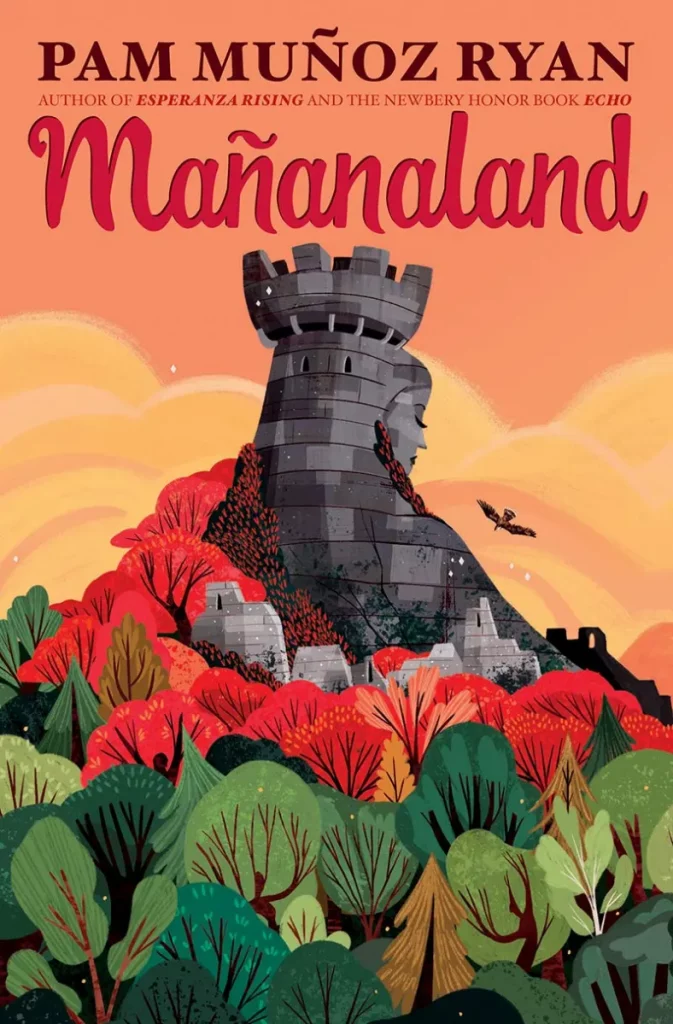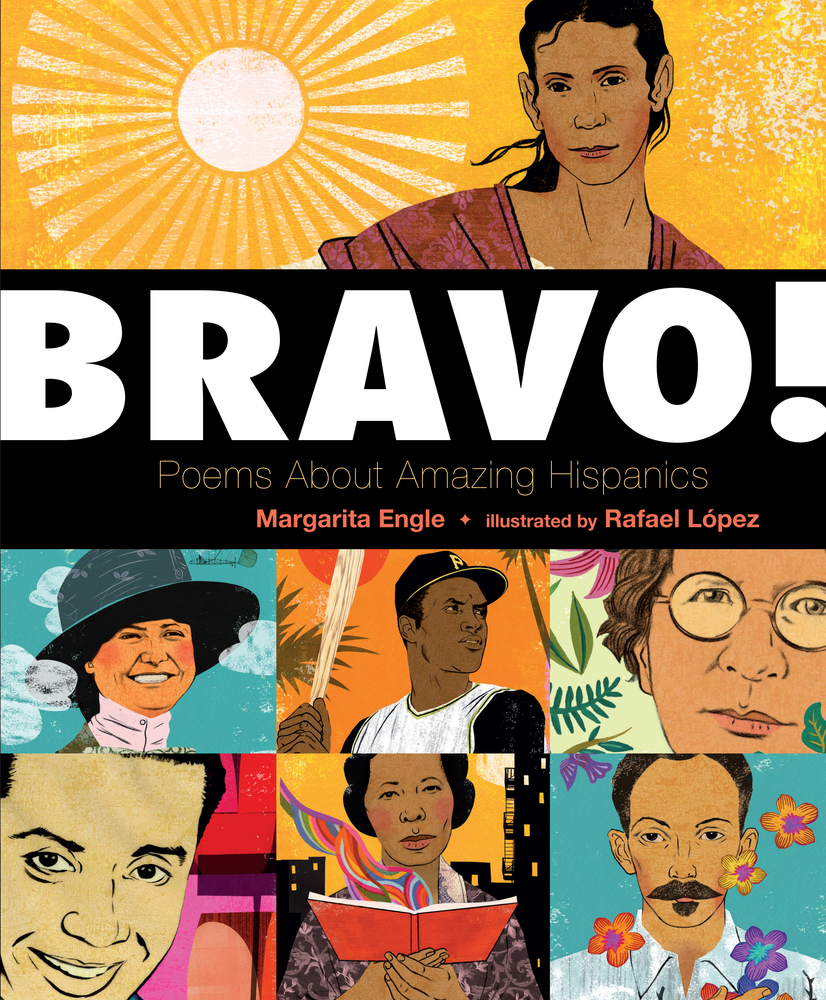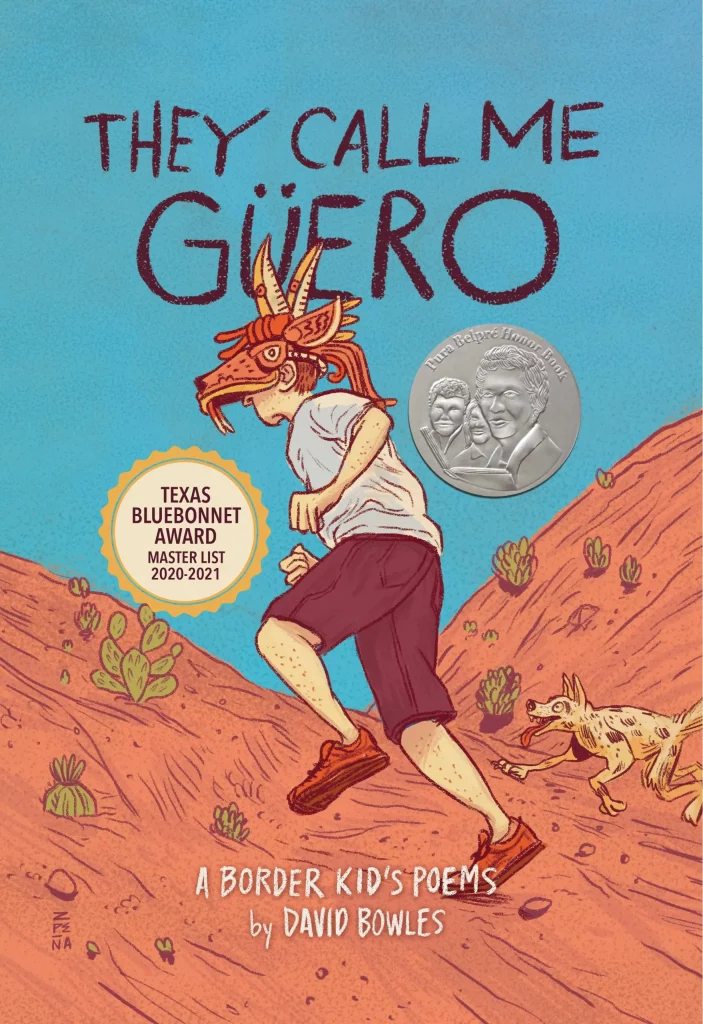
1. Bibliography
Ryan, Pam Muñoz. 2020. Mañanaland. New York: Scholastic. ISBN 9781338157864
2. Plot Summary
Maximiliano Córdoba is not looking forward to his summer break. While his friends head off to a free fútbol camp, Max feels constricted by his Papá’s overprotective grip. Instead of training with the other boys for the fast-approaching soccer tryouts, Max has to work for his father, the bridgebuilder of the village of Santa Maria, all summer long. Luckily, Papá and Buelo (Max’s grandfather) were both famous fútbolistas, so he won’t miss out on training. But fútbol training isn’t Max’s only worry. As tryouts approach, Papá reveals that he does not have the mandatory birth certificate that Max will need to prove his age and citizenship. Papá must go on a long journey to fill out the necessary paperwork. But when Max learns of a family secret that involves smuggling refugees from the country of Abismo, he realizes that tryouts are the least of his worries. Max will have to learn to take on the mantle of responsibility or face dire consequences for himself, his family, and the young refugee entrusted to his care.
3. Critical Analysis
Max and his family live in a realistic modern setting, signaled by the transportation, sports pursuits, and technology that are a part of their world. In other words, Max’s world is much like our own. But while the setting of Mañanaland is realistic, the countries of Santa Maria (where Max lives) and Abismo (where the refugees flee from) are not real coutries. Furthermore, the reappearing female peregrine falcon (hinted at in the text as the spirit of grateful refugees), Max’s dreams (revealing the lyrics to the forgotten song that Max’s mother used to sing to him), and Max’s boat ride home (in which Max thinks he may have seen his future) blur the lines between fantasy and reality. This distinct style known as magical realism, mixing modern and fantastic, is a beloved style in Latine culture and is found at the heart of Mañanaland’s story, signaling its proud homage to its literary roots—writers like Gabriel García Márquez and Jorge Luis Borges. The style invites readers to find magic in their own lives and, just like Max, Buelo, and finally Papá, to view the “happy coincidences” that life brings as more than mere happenstance.
Beyond the cultural markers found in the genre of the story itself, the themes present in Mañanaland are timely messages that, sadly, continue to cause grief to many members of the Latine community today. Pam Muñoz Ryan deftly navigates themes of political violence, the crisis of fleeing refugees, and the backlash from neighboring countries. In the country of Abismo (an emblematic name that means “Abyss” in English), a dictator incites war, forcing “legions of people” to flee the violence, and the neighboring country of Santa Maria to pass the “Harboring Law” which states that refugees from Abismo are illegal and that nobody can help or hide them. Max’s family becomes part of a secret group, Los Guardianes de los Escondidos (The Guardians of the Hidden Ones), who try to help refugees through Santa Maria into another country so that they can find a better life.
The book certainly marks itself as a Latine title from Santa Maria’s love of fútbol to the intimate intergenerational connection that Max shares with his father, grandfather, and great aunts and uncles. Max lives in a three-generation household—grandfather, father, and son. The duties associated with being a part of the Córdoba household carry immense weight for Max as he works with his father as the bridgebuilding protégé and as the next Guardia in a long line of selfless refugee guides. It is also through his grandfather than Max learns the important oral legends that lead him and Isadora safely to refuge. Oral history provides essential guidance.
Mañanaland is a phenomenal middle-grade novel, not just for its Latine cultural output and its ultra-relevant social themes that will get kids thinking, but for its focus on bravery, love, and hope despite uncertainty. Ryan has written herself another winner. This book belongs in every middle grade library.
4. Rewards and Review Excerpts
International Latino Book Award, 2020, Winner, Best Fictional Youth Chapter Book
Cybils Award, 2020, Middle Grade Fiction Nominee
New York Times Notable Children’s Books List, 2020, Middle Grade
Publishers Weekly Best Children’s Books List, 2020, Middle Grade
Kirkus Best Middle Grade Books List, 2020
From Booklist: “In her first book since the Newbery Honor winning Echo (2015), Muñoz Ryan crafts a lyrical, fablelike tale of love, loss, community, and standing up for what is right. The novel is told with evocative and dreamlike writing and features authentic characters who tug at the heartstrings. As the impeccable pacing keeps readers guessing, the timely story line will resonate, especially bringing to mind the plight of young people who have to travel long distances in unfamiliar lands to find safety. This story, infused with magic, reminds children that humanity thrives when people embrace differences and construct bridges instead of borders. Another unforgettable work from a master storyteller.”
From Kirkus: “A boy journeys to self-discovery through the power of stories and traditions. . . . Kirkus Prize winner Ryan (Echo, 2015) beautifully layers thought-provoking topics onto her narrative while keeping readers immersed in the story’s world. Although set in the fictional country of Santa Maria, ‘somewhere in the Americas,’ the struggles of refugee immigrants and the compassion of those who protect the travelers feel very relevant. This tightly packed, powerful fantasy contains resonant truths.”
5. Connections
Learn more about refugees by doing some research together. You might look up statistics and stories from places like Amnesty International or UNHCR. You might consider ways you can volunteer to help refugees in your local community by browsing opportunities together on platforms like JustServe.org.
Create a display of children’s books highlighting refugees. This selection might include the following:
- Maclear, Kyo. Story Boat. ISBN 9780735263598
- Văn, Mượn Thị. Wishes. ISBN 9781338305890
- Guidroz, Rukhsanna. Samira Surfs. ISBN 9781984816191
- Umrigar, Thrity. Sugar in Milk. ISBN 9780762495191
- Phi, Bao. A Different Pond. ISBN 9781479597468
- Rodkey, Geoff. We’re Not from Here. ISBN 9781524773076
- Buitrago, Jairo. Two White Rabbits. ISBN 9781554987412
- Adewumi, Tanitoluwa. Tani’s New Home. ISBN 9781400218288
- Jamieson, Victoria, and Omar Mohamed. When Stars Are Scattered. ISBN 9780593162576
*Note—This book review was created as an assignment for a course at Texas Woman’s University.

